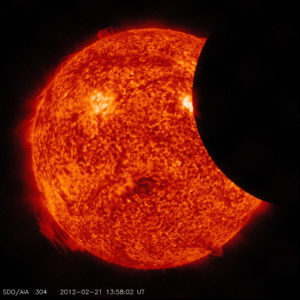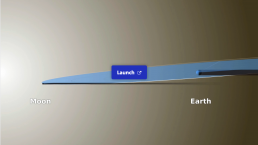Resources
Annular Eclipse Features
Annular Eclipse Features
The Eclipse Begins


During an annular eclipse, the Moon blocks the Sun, but not completely. From Earth, the Moon does not appear big enough to block out the Sun entirely.
This image is from moments after what is called “First Contact.” At First Contact the Sun appears as a glowing, white disk against a black background. On the left side of the Sun, a small, U-shaped area appears missing from the Sun’s perfect circle shape. This missing area is the Moon as it creeps in front of the Sun slowly starting to block out the Sun’s light. The Moon appears to be taking a bite out of the Sun like a bite out of a cookie.
Usually the Moon’s deep craters make the Moon appear rough. But now, the Sun’s light is so bright that it erases all of the Moon’s features. This causes the Moon to appear black and smooth like glass. The intensity of the Sun’s light makes it unsafe to look at the annular eclipse without always wearing special eye protection.
This image was taken in 2012 by astronomer and science writer Dr. Rick Fienberg. Dr. Fienberg used a digital camera and zoom lens capped with a special-purpose filter to block 99.999% of the Sun’s dangerously bright light. You should never take photos of an eclipse without a special solar filter. The bright light of an eclipse can damage a camera, as well as your eyes! A solar filter helps protect the camera and your eyes. A solar filter fits over the front of a telescope lens and is specifically designed to limit the amount of light without adding color.
Dr. Fienberg has been chasing total solar eclipses around the world for 30 years! He observed and photographed this eclipse from a cruise ship in the Pacific Ocean near Australia.
Annular Phase Begins with Baily’s Beads


This image is of the phenomenon called “Baily’s Beads.” In this stage the Moon has moved in front of the Sun. The Sun’s light is reduced to a thin C-shape or crescent, shining at the edge of the Moon.
Baily’s Beads look like a few glowing pearls at the ends of the crescent. Baily’s Beads occur because the Moon’s surface is not smooth. It is covered by mountains and valleys. Baily’s Beads are caused by Sunlight beaming between the mountains and through the valleys on the Moon when the Sun begins to peek around the Moon’s edge.
After Baily’s Beads disappear, the Annular Phase begins.
Baily’s Beads are named for an English astronomer named Sir Francis Baily. Sir Francis published his observations after seeing these bright beads of light during the May 15, 1836 annular solar eclipse. And, even though Sir Francis was not the first person to observe this phenomenon, he was the first to publish his observations.
This image was taken by Talha Zia in Sukkur, Pakistan. Talha did not use a solar filter, which can be dangerous. To protect their eyes, Talha did not look into the lens. Talha set up a camera with a telescope on a motorized mount that followed the Sun. To protect the camera lens, Talha limited the amount of light by setting a very short exposure time.
Visit the Rumble Map to explore this image of Baily’s Beads through touch and sound. The absence of light is silent and still. Can you feel and hear where the Sun’s light creates several beads dotted along a ring of light?
Annularity


This image is of Annularity, when an annular eclipse is at its maximum point. During Annularity, the dark black Moon appears smooth like glass and blocks the center of the Sun. Only a thin ring of light shines around the edge of the round Moon. As a result, the Sun appears to be a very bright ring of fire rather than a glowing ball. This ring of light may only appear for a few minutes. This spectacular feature is why annular solar eclipses are often called “Ring of Fire” eclipses. This ring shape is also why this type of eclipse is called an “annular” eclipse. This ring shape is known as an annulus in mathematics. The word “annular” means “little ring” in Latin. During an annular eclipse the Moon blocks all but this outer ring of the Sun’s surface. An annular eclipse is just one type of eclipse. Total solar eclipses are another type. During a total solar eclipse the Moon completely covers the surface of the Sun.
This image was taken by amateur astronomer Talha Zia during the June 21, 2020 eclipse in Sukkur, Pakistan. Talha is a member of the Karachi Astronomers’ Society. If you’d like to photograph an eclipse, you will need more than just a telescope or camera! To protect your telescope, AND YOUR EYES, you need to use a special solar filter. This is similar to a very dark piece of glass that fits over the front of your camera or telescope lens. The filter is designed to limit the amount of light without adding color to the image.
Annularity Phase Ends


This image was taken as the annular phase ends. The Moon is slowly creeping away from the center of the Sun. As the dark, circular Moon blocks less of the Sun’s bright light, the Sun’s fiery ring of light slowly transforms into a bright crescent shape once again. Depending on your location, Baily’s Beads might be visible again. Baily’s Beads appear like glowing pearls at the ends of the Sun’s glowing crescent.
This image was taken by Talha Zia in Sukkur, Pakistan. Talha did not use a solar filter on their camera, which can be dangerous. To protect their eyes, Talha did not look directly into the camera. Talha set up the camera with a telescope on a motorized mount that followed the Sun. To protect the camera, Talha limited the amount of light by setting a very short exposure time.
The Eclipse Ends


This image is of the end of the annular eclipse. The Moon is slowly moving completely out of the Sun’s way.
While the Moon still appears as a black disk, the Sun is a fiery ball of swirling red and orange. As it moves, the Moon looks like it is taking smaller and smaller bites out of the Sun. In this image, the Moon blocks a small area on the right side of the Sun.
Fourth Contact is the end point of the annular eclipse, when the Moon’s edge moves past the Sun’s edge, and no longer blocks any part of the Sun’s light.
This image was taken by the Atmospheric Imaging Assembly telescope on board NASA’s Solar Dynamics Observatory. This observatory is currently in orbit around the Earth. Its telescope takes eight images like this one every ten seconds. These images help scientists better understand the Sun.
July 11, 2022
Total Eclipse Features
Total Eclipse Features
Corona


During the totality, the moon completely covers the sun’s glowing orb, and the sun’s outer atmosphere is revealed. As if the moon were the center of a celestial sunflower, the corona appears as soft white petals, massive flumes of faint light that taper out across the sky. Closer to the surface of the moon’s flat ebony circle, the corona is a swirling chaos of loops and flares. Intense fiery lines of light appear to ignite the moon’s black edge.
How to interact with the rumble map
On the rumble map, explore the difference between the moon and the sun’s corona. You will hear/feel variations as your fingers pass over different features of the corona.
Additional scientific info:
The corona is the thin outer atmosphere of the Sun. With temperatures at over 1 million degrees Fahrenheit, it radiates light in wavelengths that are too short for the human eye to see (like X-rays) and that are absorbed by the Earth’s atmosphere. However, the corona reflects some of the white light from the Sun’s photosphere below it. This faint reflection is only seen when the much brighter photosphere is blocked, like during a total eclipse.
Helmet Streamers


Projections of light from the sun’s outer atmosphere called helmet streamers extend in all directions from behind the moon. In contrast to the black, featureless moon, the pale, wispy streamers appear as delicate as lace. The largest streamers have a tapered shape that resemble flower petals. They extend from opposite sides of the sun, with smaller rays of light between them.
Explanation of what you might feel as you interact:
As you trace your finger along a helmet streamer, you can feel the smooth arches come to long sharp points as they extend from the base of the Sun outward.
Additional scientific info:
Helmet streamers get their shape from two different processes. The arch shape of streamers come from magnetic fields from concentrations of magnetic field on the surface of the Sun extending out into the corona and then arching back down to the surface to connect to other regions of magnetic field of opposite polarity. The long, pointed tops of helmet streamers come from streams of gas flowing out from the corona into interplanetary space forming the solar wind.
Prominence


Fiery loops of hot pink light appear to leap off the moon’s black surface. With the sheer white corona as their backdrop, these pink prominences seem to dance above the moon like lines of liquid neon.
Explanation of what you might feel as you interact
You will notice a sharp contrast when you interact with a prominence due to its intense brightness relative to both the moon and the sun’s corona.
Additional scientific info
Prominences are magnetic fields that are filled with very dense material making them much brighter than the surrounding background. The magnetic fields of prominences can be very complicated giving them complex and dynamic shapes.
Baily’s Beads


On the right side of the moon, orbs of glowing sunlight shimmer off the edge of the moon’s black disk. Called Baily’s Beads, these final areas of the sun’s light appear as glimmering pearls on a wire, made intensely bright by the absence of light surrounding them.
Explanation of what you might feel as you interact
On the rumble map, explore the difference between the moon, the sun’s corona and Baily’s beads which are intense and irregular.
Additional scientific info
Even this small section of the Sun’s light cannot be viewed without special eye protection. Please use special eclipse glasses or filters if viewing this feature directly on the Sun with your eyes. Baily’s beads are caused because the moon’s surface is not a smooth, perfect sphere. This spectacular feature is caused by rays of sunlight beaming through the ravines and valleys between mountains on the moon.
Diamond Ring


On the left side of the black moon, a sliver of sunlight blasts into view with white-hot intensity. As the area of re-emerging sunlight grows, it resembles a diamond, beaming out its brilliant light from its setting on the circular ring of the moon’s edge.
Additional scientific info
Even this small section of the Sun’s light cannot be viewed without special eye protection. Please use special eclipse glasses or filters if viewing this feature directly on the Sun with your eyes. As the moon barely moves away from the solar surface, the powerful light of the Sun peers around the side of the moon. This light is so intense that even this small fraction of it dominates the sky.
Totality


This is the full eclipse, when the moon’s black disk completely covers the sun. Now, in the absence of the sun’s full light, its massive outer corona is revealed. Uniquely visible during a full eclipse, grand flourishes of light called helmet streamers extend in all directions behind the moon’s black disk. At the edge of the moon, the helmet streamers are intensely bright, fading to wisps of ghostly white as they stretch across space, far from the moon, like flower petals.
Explanation of what you might feel as you interact
On the rumble map, explore the difference between the moon and the sun’s corona.
Additional scientific info
You may notice changes in temperature and natural sounds, such a birds and wind during the total eclipse.
During the total solar eclipse, and only during totality, you can view the corona of the Sun without eye protection. The Sun’s outer atmosphere, the corona, is in full display and viewable from the ground. The highly structured nature of the corona is clearly evident. This structure is caused by the Sun’s intense and complicated magnetic fields interacting with the material that makes up the corona. This material is called a plasma, which is like a gas, but is susceptible to magnetic fields. The magnetic fields can then shape the plasma in the corona into the complicated patterns that are viewable during the eclipse.
July 11, 2022
What Can We Learn from Solar Eclipses?


A history of lessons learned and questions still to be answered
Solar eclipses are more than an exciting cosmic phenomenon, they have played a key role in helping humans understand the universe. By observing eclipses, scientists learned about the size and shape of the Sun, the Moon, and the Earth. Eclipses clued-in early astronomers to the orbits of the celestial bodies and how they relate to one another. Copernicus’ theory of heliocentrism cemented the understanding that solar eclipses occur when the Moon passes in front of the Sun. And just like that, public perception of eclipses shifted from a frightful darkening of the skies to an opportunity to learn more about the cosmos.
Studying the Corona
One of the first great modern discoveries surrounding an eclipse occurred in 1868. French solar physicist Jules Janssen discovered a new element while observing the Sun’s chromosphere through a prism. Astronomers named the element Helium, after Helios, the Greek god of the Sun. It would be more than 25 years before helium was discovered on Earth, but we now know it’s the second most common element in the universe.
Janssen was neither the first scientist nor the last to study the outer atmosphere of the Sun during an eclipse. A solar eclipse offers a unique chance for scientists to view the Sun’s corona. “Most of what we know about the corona is deeply rooted in the history of total solar eclipses,” Lina Tran wrote for NASA Goddard. “Before sophisticated instruments and spacecraft, the only way to study the corona from Earth was during a total eclipse, when the Moon blocks the Sun’s bright face, revealing the surrounding, dimmer corona.” An instrument called a coronagraph can mimic eclipse conditions on a telescope, but eclipses still remain the most authentic way to study the corona from Earth.
The Coronal Heating Problem
Scientists thought they discovered yet another new element in 1869 as they observed an eclipse through a spectrometer. A spectrometer helps scientists determine which elements compose a band of light, but the green line that appeared in 1869 didn’t correspond to any known element. Scientists briefly called the new “element” Coronium, but Swedish astronomer Bengt Edlén later determined that the element was superheated iron.
The extreme temperature of the iron indicates that the corona is 2 million degrees Fahrenheit — nearly 200 times hotter than the surface of the Sun. This phenomenon is known as the “Coronal Heating Problem.” The layers of the sun typically become cooler and less dense as they move outward from the core, so scientists are not sure why the corona would be significantly hotter than the surface below it. Heliophysicists believe this may be caused by wave heating, or perhaps nanoflares, but further study of the corona is necessary before we know for certain.
Solar Winds
The corona is full of other fascinating features. Eclipses give astrophysicists a good look at the behavior of loops, streamers, and coronal mass ejections. They are also an opportunity to learn about solar winds: charged particles that emanate from the corona. Solar winds are important in that they define the boundary of our solar system and protect us from cosmic radiation. On the downside, they can disrupt our satellite and GPS-based communications. During an eclipse, researchers can take more accurate temperature readings of solar winds. Interestingly enough, solar wind temperatures do not seem to fluctuate in tandem with the solar cycle. It’s another mystery that may require more solar eclipses to solve.
The Earth’s Ionosphere
Eclipses don’t just tell us about the Sun. We can also learn more about our own atmosphere here on Earth. The ionosphere is the upper level of the Earth’s atmosphere. During the daytime, the ionosphere is “charged” because “energy from the sun and its corona feed extreme ultraviolet photons into this area, creating free electrons and ions,” physicist Phillip Erickson told Slate. The ionosphere is less active at night. An eclipse is like a light switch for the ionosphere, turning the charge off and back on again as the Moon passes in front of the Sun. This allows scientists to study changes in real-time, and can provide clues about how the ionosphere affects communications and space weather.
Studying Other Structures
Eclipses also offer insight into other structures in the solar system. Some scientists have used the occasion of an eclipse to take more accurate thermal readings of Mercury. Others have embraced eclipses as a model that makes our stratosphere more “Mars-like.” During an eclipse, UVA and UVB levels in our upper atmosphere more closely resemble those on Mars, allowing researchers to test microbial responses to Mars-like conditions.
An eclipse also led to one of the most important “proofs” in modern science — a test of Einstein’s Theory of Relativity. Einstein’s theory posited that light shifts as it passes by a massive body (like the Sun). In 1919, researchers noted that the light from stars shifted before, during, and after a total solar eclipse. It appeared that Einstein guy was right all along.
Studying Life on Earth
These days, instruments like the Parker Solar Probe are teaching us about the Sun (and other structures) in ways we never imagined. But that doesn’t mean the days of learning from eclipses are through. Eclipses present a unique opportunity to learn about changes in our solar system. And some of those changes occur right here on Earth.
During the Eclipse Soundscapes: Citizen Science Project, we’ll be studying how life on Earth responds to those changes. Anecdotal evidence suggests that we could experience altered animal behaviors and sounds (for example, nocturnal animals calling during the eclipse, or diurnal animals producing a “false dawn chorus” as the light re-emerges). We’ll be taking soundscape recordings before, during, and after the eclipse. Then, we’ll analyze the recordings for any patterns or anomalies. Interested in joining us? Sign up here to be a part of the project!
The Science of Soundscapes
What is a soundscape?
Have you ever listened to an album of relaxing nature sounds, like rains falling or whales singing? That’s a soundscape! Soundscapes include any noises that humans hear in a given environment.
There are three major types of sound that can be found in soundscapes:
- Biophony: Sounds generated by organisms (like bird song and cricket chirps)
- Geophony: Sounds generated by the non-biological natural world (like wind and water noise)
- Anthropophony: Sounds generated by humans or human-made technology (like human voices or vehicle traffic).
The study of soundscapes encompasses several disciplines, including acoustic ecology, bioacoustics, and soundscape ecology. The Eclipse Soundscapes Project focuses primarily on soundscape ecology.
What can we learn from soundscapes?
Soundscape ecology is an emerging field (established in 2011 by the article “Soundscape Ecology: The Science of Sound in the Landscape”). Scientists are still learning about the many ways it can be useful. The purpose of soundscape ecology is to explore the relationships between living organisms (including humans) and their environment. Soundscape ecologists use recording devices to collect soundscapes, then analyze the results using a spectogram: a visual representation of how sound frequencies vary over time.
Soundscapes themselves are valuable to conservation. There is a push to preserve soundscapes in delicate ecosystems, since changes in climate or excessive human impact may cause soundscapes to alter or disappear. Some agencies, like the U.S. National Park Service’s Natural Sounds and Night Skies Division, are working to protect soundscapes by collecting recordings and preserving acoustic environments.
The analysis of soundscapes can also be beneficial to science. Acoustic data tells us about the environment, its health, and how different species behave and interact within it. We can make simple observations about which life forms are present in a habitat, and when they are most active or vocal.
We can also form hypotheses that explain why animals behave in certain ways. Some research has shown that organisms will change their call’s timing and/or frequency so as not to interfere with other sounds in their physical environment. For instance, some frogs communicate their territorial calls using high frequencies. This may be a natural adaptation to their habitat, where the low frequency sounds of running water are prevalent. Other behavioral changes may happen in response to anthrophony: some birds will adjust their songs in environments where there is a lot of human-generated noise.
Soundscape ecology overlaps with sensory ecology, which focuses on how and why organisms gather information from their environment. Some organisms take advantage of soundscape noise to navigate or to hunt, while other organisms may take busy auditory signals as a sign of danger. From this data, we can research not only how ecosystems impact soundscapes, but how soundscapes impact ecosystems.
Another benefit of soundscape research is that it encourages interdisciplinary and cross-disciplinary study. Ecologists, social scientists, engineers, astrophysicists, and musicians have all turned to soundscapes to help broaden their field of research.


Are soundscapes the same as sonification?
Soundscapes and sonification are not the same, but they are somewhat related!
Sonification uses audio to convey information or perceptualize data. There is a lot of great work currently being done in the field of sonification! For example, our friends at NASA’s Chandra X-Ray Observatory have used data sonification to turn the light from astronomical images into sound. Think of it like translation. Sometimes we are limited in our ability to see scientific data, but if we translate it into another medium like audio, we may be able to hear it. And because auditory perception has some advantages (in that it allows us to perceive temporal, spatial, amplitude, and frequency information) it may help us understand the information even better.
One major advantage of data sonification is that it opens doors for people who do not learn visually, including people with blindness or vision impairments. This is also true of soundscapes!
What is an Eclipse Soundscape?
The Eclipse Soundscapes Project will explore how celestial events, like eclipses, can impact life on earth. By collecting and studying soundscapes prior to, during, and after eclipses, we hope to better understand how eclipses change human and animal activity. There is some anecdotal evidence that the changes in light an eclipse causes may influence animal behavior. For instance, nocturnal animals may stir when it starts to get dark, and diurnal animals may vocalize as the eclipse passes and the light returns — this phenomenon is known as a “false dawn chorus.”
These accounts are anecdotal, and to date there is little scientific evidence to prove or disprove these occurrences. By recording a variety of soundscapes and analyzing spectrograms, our scientists hope to identify trends in animal behavior.
To do so, we’re working with a bioacoustic advisory board, featuring some of the top specialists in soundscape ecology and related fields. Our board members include Dr. Megan McKenna of Stanford University’s Goldbogen Lab, Dr. Bryan C. Pijanowski of Purdue University’s Center for Global Soundscapes, Dr. Laurel Symes of The Cornell Lab of Ornithology’s Center for Conservation Bioacoustics, and Sound and Light Ecology Team Research Associate Dr. Jacob Job
We’ll be introducing the team and their work in future blog posts, so stay tuned!




